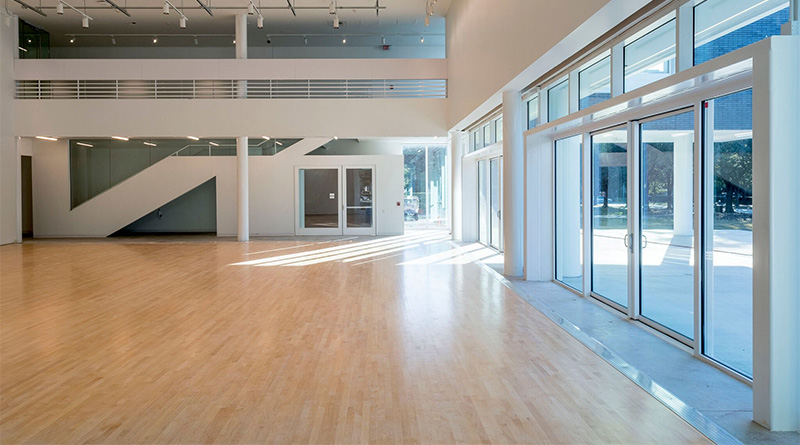Construction shot of the Moody Center for the Arts at Rice University, Flexible Gallery, December 2016.
Photo by Nash Baker.

“We are putting in a dance floor,” Alison Weaver told me during a hard hat tour of the Moody Center for the Arts, which opens this month on the campus of Rice University. As you might guess, these are dangerous words to say to any dance writer, especially one who has written extensively about dance in alternative spaces. It took all of my restraint not to send her the bundle of stories that I have written about that subject in this very space. Museum and visual arts organizations have been opening their doors to dance for decades. It’s not even a trend anymore; it’s the next home for dance.
For Weaver, dance is an obvious choice. “Historically, Rice has done a good job with music with the Shepherd School of Music and with the PhD program in Art History. Dance has been less emphasized.” And she’s right, there’s no dance major at Rice. I do want to acknowledge that the student club, Rice Dance Theatre, has been going strong for decades. Recent years have included such prominent artists in residence as Lydia Hance, Ashley Horn and Lori Yuill.
The Moody Center opens its stylish 50,000 square foot building, designed by Michael Malztan, on Feb. 24 with an array of programs and exhibits, including works and events by Olafur Eliasson, Thomas Struth, Diana Thater and Mona Hatoum.
But let’s get back to that dance floor that I am so excited about. Did I mention it’s a sprung wood floor? This is huge for dancers. The Flexible Gallery Space is an open, sunny expanse, which will work well for the kind of museum-based dance works happening today. (And there’s also a flexible black box theater, too.) The first dance moves on that floor will be performed by the Brooklyn-based Dušan Týnek Dance Theatre, who will be in residence during the opening week. The residency will culminate in a performance at James Turrell’s Twilight Epiphany Skyspace at Rice on Feb. 24-25. This isn’t Týnek’s first Turrell rodeo; his company created a site-specific work for the Skyspace at the Ringling Museum of Art in Sarasota, Florida, which is exactly how he connected to Weaver.
Týnek describes the mission of his company as threefold: to create works with commissioned scores; site-specific work; and works that intersect with scientific ideas. The choreographer finds that site-specific work is more inclusive. “The audience can be part of the dance,” says Týnek. “I find they are much more open to what is happening in front of them. They are less frustrated, and don’t worry so much about what figuring out the story.” For the Rice Skyspace, Týnek will draw from material from the prior piece and create new material during his residency, which will take place across three spaces: The Moody Center, the dance studio and the Skyspace.
Kurt Stallmann, Associate Professor of Composition and Theory Director of the Rice Electroacoustic Music Labs, will be creating the music for the piece. Stallmann is planning a mix of live and recorded sound, mostly using voice. He envisions an immersive experience that will include a mass of voices and make use of the structure’s 12 speakers, which he was instrumental in putting in place during the design process of the Skyspace.
It’s way too soon to know exactly how dance will flourish at the Moody Center. It’s exciting that the mission encompasses all the arts, and aims to be an incubator for ideas and creative endeavors serving students, faculty and visiting artists. Weaver is eager to get the place up and running, and remains open to many possibilities. She has her ear to the ground to learn more about dance in Houston and elsewhere. But really, what better welcome to the field than investing in a real dance floor?
—NANCY WOZNY

